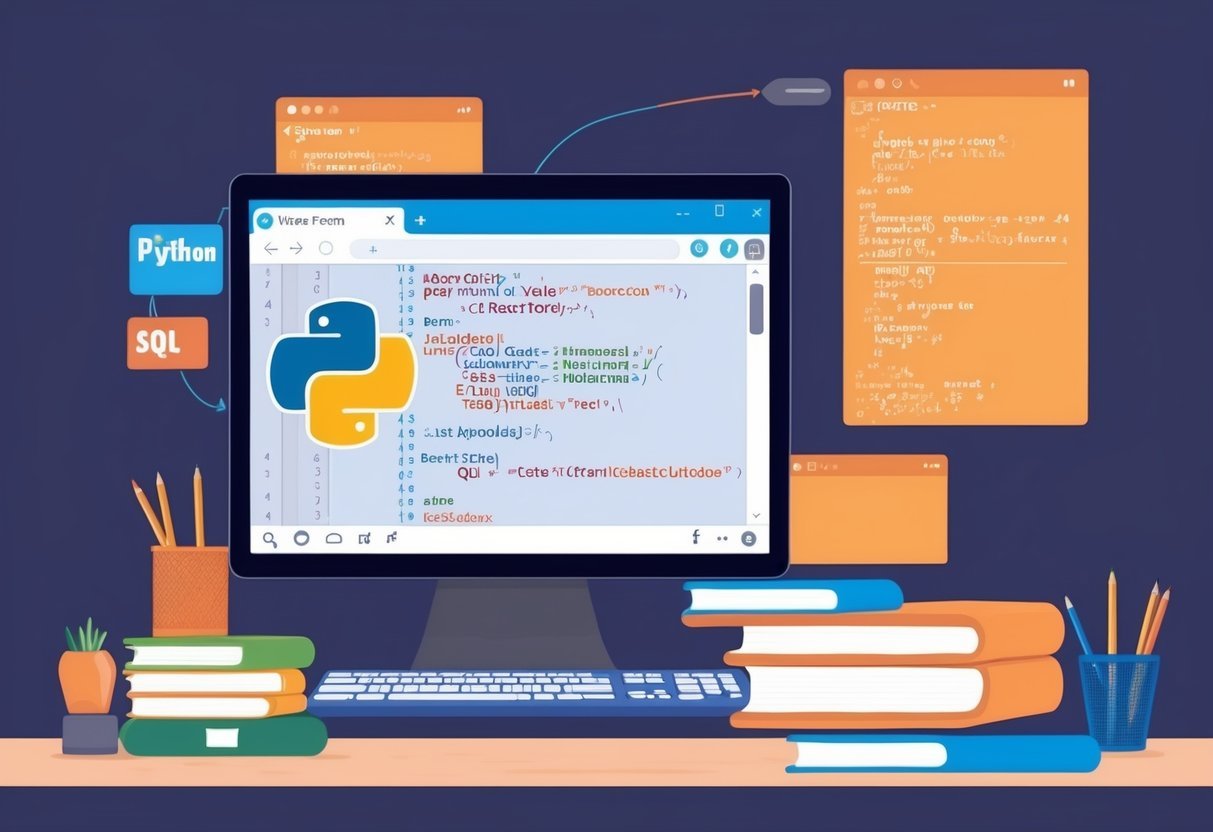Python and SQL Integration
Python and SQL work well together to streamline data management and enhance data analysis. The combination leverages Python’s programming skills with SQL’s database efficiency, making it ideal for tasks ranging from data extraction to transformation and storage.
Understanding the Synergy Between Python and SQL
Python and SQL serve different but complementary roles in data management. Python is a flexible programming language known for its readability and wide-ranging libraries. It excels in manipulating and analyzing data.
SQL, or Structured Query Language, is a domain-specific language used for managing and querying relational databases. Together, they provide a powerful framework for data-driven tasks.
Python can handle complex data operations, using SQL for tasks like data retrieval and management from databases. Libraries such as pandas and NumPy can enhance these operations by providing robust data manipulation capabilities. This synergy maximizes efficiency, enabling users to focus on analyzing data rather than dealing with data logistics.
Setting up Python for SQL Tasks
To start with SQL tasks in Python, the setup process is critical. One must install a Python distribution, such as Anaconda, which simplifies package management.
Installing essential libraries like sqlite3, SQLAlchemy, or psycopg2 allows Python to communicate with various databases without setting up complex environments.
Creating a virtual environment helps manage dependencies and version control. This is done using venv or virtualenv in Python.
Once the setup is complete, the user can connect Python to different databases, executing SQL queries directly from Python scripts. This preparation is fundamental for effective data analysis and manipulation.
Introduction to Database Connectors
Database connectors are crucial for integrating Python with SQL databases. They enable interaction between Python applications and databases, translating Python commands into SQL queries that the database can execute.
Popular connectors include psycopg2 for PostgreSQL, MySQL Connector/Python for MySQL, and SQLite3 for SQLite databases.
Using connectors ensures secure and efficient database access. Connectors not only facilitate direct SQL query execution but also help in automated tasks like ETL (Extract, Transform, Load) processes. Understanding and utilizing these connectors is vital for anyone aiming to leverage the full potential of combining Python with SQL. They bridge the communication gap, enhancing the capability of both technologies when used in tandem.
Database Fundamentals and Operations
Understanding how databases work and how to manage them effectively is key in data management. The focus here is on the structure and operations, touching on relational databases, SQL commands, and transaction management.
Relational Databases Explained
Relational databases store data in structured tables with rows and columns. Each table represents an entity, and the rows represent individual records. Primary keys ensure each record is unique, while foreign keys link tables together, maintaining data integrity.
These databases use Structured Query Language (SQL) for data manipulation. They’re unique for supporting complex joins, which combine data across multiple tables. Relational databases are ideal for scenarios requiring consistent, repeatable transactions like financial records.
SQL Operations and Command Essentials
SQL is a powerful tool used for managing and querying databases. Basic SQL operations include SELECT, INSERT, UPDATE, and DELETE. These commands allow users to retrieve, add, modify, and remove data from the database, respectively.
SELECT queries are the most common, retrieving specific data from tables. INNER JOIN and LEFT JOIN are used to extract related data from multiple tables.
SQL allows for complex filtering and aggregations using WHERE, GROUP BY, and HAVING clauses, enabling detailed and tailored data extraction.
Transaction Management and Views
Transactions are a sequence of operations that must be completed successfully for data integrity. They follow the ACID properties: Atomicity, Consistency, Isolation, and Durability.
COMMIT and ROLLBACK commands ensure transactions are finalized or reversed in case of errors.
Views act as virtual tables, allowing users to save SQL query results for repeated use. They simplify complex SQL queries by storing query logic, improving efficiency in data retrieval. Views help present data in user-friendly formats, hiding complex details from general users.
Advanced SQL Queries and Python
When combining Python with SQL, users can write more efficient and powerful scripts. This integration allows handling complex data tasks, writing sophisticated queries, and managing connections effectively.
Writing Complex Queries with Python
Python offers tools like pandas and SQLAlchemy to enhance SQL query capabilities. Users can create complex SQL queries using subqueries and advanced functions.
Libraries like SQLAlchemy help in constructing those queries, allowing users to interact with databases within Python scripts.
Subqueries can fetch targeted data sets, enabling users to streamline their data analysis. By automating these processes, repetitive tasks become easier to manage. This method helps in reducing errors and improving execution speed.
Utilizing Cursors and Joins in SQL
Cursors and joins are vital parts of SQL, especially when managing extensive datasets. A cursor allows for row-by-row processing, making it suitable for operations that require precise control.
Using Python, users can harness cursors for more detailed data manipulation.
Joins combine data from multiple tables, bringing together related information. They are powerful in data analysis, providing a comprehensive view of linked datasets.
Mastering joins enables users to build more insightful queries, which is crucial in advanced data analytics.
Managing Query Strings in Python
Handling query strings within Python requires precision and understanding of both SQL and Python syntax. This process involves crafting dynamic and parameterized queries that adapt to different inputs.
Using libraries like psycopg2 or SQLite3, users can manage query strings efficiently.
These libraries ensure that data is processed securely and that queries are executed correctly. They also help prevent SQL injection attacks by allowing for safe handling of query parameters. This approach not only fortifies security but also boosts the performance of SQL operations within Python applications.
Python Libraries for SQL Enhancement
Python offers powerful libraries that can significantly enhance SQL tasks. By using libraries such as Pandas, NumPy, and data visualization tools, data manipulation, analysis, and presentation become more efficient and dynamic.
Pandas for SQL Data Manipulation
Pandas is a popular Python library for data manipulation and analysis. It provides efficient ways to manipulate tabular data and carry out operations like filtering, grouping, and aggregating data similar to SQL.
With Pandas, importing SQL queries directly into Python as DataFrame objects allows for easy manipulation and transformation. It integrates seamlessly with SQL databases, making it a valuable tool for data scientists and analysts.
Users can perform SQL-like operations such as JOINs, subqueries, and group by using simple Pandas commands.
For instance, the merge() function mimics SQL JOINs, and the groupby() function provides functionalities similar to SQL GROUP BY. This versatility allows users to handle large datasets effectively without complicated SQL queries. With Pandas, tasks that might require complex SQL can be achieved with simple Python code, fostering a more flexible approach to data manipulation.
Numpy for Handling SQL Data Arrays
NumPy is another essential Python library used in conjunction with Pandas to enhance SQL data tasks. Known for its powerful numerical computations, NumPy allows for the effective handling of large multi-dimensional arrays and matrices, which is crucial in data processing.
Its array manipulation capabilities complement SQL operations by enabling efficient data structure transformations.
Through NumPy, users can perform complex mathematical and statistical operations on SQL data more efficiently. It is particularly useful in scenarios where SQL data needs to be reshaped or subjected to linear algebraic or statistical computations.
NumPy’s high-performance multidimensional array object, alongside a wide range of functions, makes it indispensable for tasks requiring rigorous numerical analysis. This library helps bridge gaps in data processing, turning raw SQL outputs into actionable insights.
Visualizing SQL Data with Python Libraries
Visualizing SQL data is crucial for understanding and communicating insights. Python offers several libraries for data visualization, including Matplotlib, Seaborn, and Plotly, that work well with SQL data.
These libraries can turn complex datasets into easy-to-understand charts and graphs, facilitating better data exploration and decision-making processes.
Matplotlib, for example, provides a robust framework for creating static, interactive, and animated visualizations in Python. Seaborn extends Matplotlib’s capabilities with simpler syntax for statistical plotting. Plotly offers interactive graphing capabilities, enabling users to create stunning dashboards.
These tools allow users to visualize SQL data in various forms, from bar charts to 3D plots, enhancing data storytelling and analysis. By integrating these visualization libraries, users can effectively display trends and patterns extracted from SQL data, making the analysis more comprehensive and impactful.
Data Analysis Techniques
Leveraging Python and SQL can enhance data analysis by combining the strengths of both tools. Python excels in data manipulation and visualization, while SQL is powerful for querying and managing databases.
Python in Data Science Workflows
Python is central to many data science workflows due to its flexibility and extensive libraries. For data analysis, tools like pandas offer functions to manipulate datasets efficiently. NumPy is key for numerical operations, and Matplotlib or Seaborn are widely used for creating visualizations.
Incorporating Jupyter Notebooks allows for interactive data exploration and makes sharing results straightforward.
Machine learning libraries, such as scikit-learn, enable predictive modeling, which is crucial in extracting insights from data patterns.
Using Python, data analysts can automate repetitive tasks, integrating with SQL databases to pull large datasets and refining them for deeper analysis. Combining these tools enhances productivity and uncovers patterns that may not be visible through SQL queries alone.
Database Management for Data Analysis
Effective database management is essential for robust data analysis. SQL is foundational for managing and querying structured datasets. It allows seamless extraction of relevant information, streamlining the preprocessing stage in data science projects.
Advanced SQL techniques can optimize queries, reducing computational load and speeding up analysis. Analysts can use SQL to clean and aggregate data, preparing it for further processing in Python.
SQL databases like MySQL or PostgreSQL can handle diverse data types and large volumes effectively, making them suitable for data science needs. Pairing SQL with Python enables analysts to take advantage of Python’s analytical capabilities while maintaining efficient database management.
Leveraging Machine Learning with SQL Data
Integrating machine learning with SQL allows for enhanced data analysis and predictive capabilities. This integration uses Python scripts, which have been supported since SQL Server 2017.
The ability to run Python and R scripts directly with SQL databases enables more efficient processing of large datasets.
Using SQL with Python for data-driven applications means that organizations can apply advanced machine learning models directly to their data. This reduces the need to move data between different platforms, streamlining workflows and minimizing data transfer times.
A combined workflow can involve extracting data using SQL, preparing it within SQL Server, and then applying machine learning algorithms using Python.
This process helps in training models and making forecasts, providing valuable insights for strategic decision-making.
Key Benefits:
- Seamless Workflow: No need to transfer data between systems.
- Data Science Capabilities: Conduct data analysis and model training within a single environment.
- Real-time Predictions: Update models and make predictions on fresh data quickly.
By leveraging both SQL and Python, organizations can harness the power of machine learning effectively. This setup makes it easier to perform predictive analytics, improving the performance and scalability of data-driven applications. Through careful integration, they can better use their existing infrastructure and expertise, making machine learning accessible across varying skill levels.
To explore more about this integration, visit articles like the one on Doing Data Science and AI with SQL Server for detailed insights.
Optimizing Web Applications with Python and SQL
Python and SQL are pivotal in enhancing web application efficiency and performance. By integrating Python’s flexibility with SQL’s robust capabilities, developers can manage data more effectively and boost the speed and scalability of web applications.
Web Application Data Handling
Web applications often need efficient data handling to keep operations smooth.
Python and SQL together allow easy access to databases, helping manage large datasets with ease.
Using tools like SQLAlchemy, developers can map classes to database tables, simplifying operations.
Simultaneous data processing is another critical aspect.
Python’s asyncio library can be paired with SQL’s parallel query execution to handle multiple requests at once, which is useful for real-time web applications. This combination enhances data retrieval and updates without putting a strain on the server.
Performance Best Practices for Database-Driven Web Apps
Optimizing web applications involves following performance best practices.
One key strategy is indexing frequently accessed database columns. This significantly improves query speeds, crucial for applications with high user traffic.
Additionally, caching query results using tools like Redis can reduce the load on databases and decrease response times.
Utilizing a connection pool can also have a positive impact. It manages and reuses database connections, improving efficiency for applications needing frequent data interaction.
Ensuring queries are properly written—avoiding unnecessary data fetching or complex joins—can drastically cut down processing times, enhancing overall user experience.
Python for MySQL Database Tasks
Python is a popular choice for performing tasks with MySQL databases. It allows users to manage data efficiently and carry out various SQL operations.
Libraries are key in this process.
Libraries like mysql-connector-python and PyMySQL help connect Python to MySQL. These libraries assist in executing tasks like data retrieval and modification.
Connecting to a MySQL database with Python is the first step.
You can use mysql.connector.connect() or PyMySQL’s connect() function. This connection is crucial for running SQL queries.
SQL Operations are simplified with Python.
You can perform tasks such as creating tables or updating records. For example, using Python, they can execute SELECT or INSERT queries with ease to interact with the database.
Here’s a basic example:
import mysql.connector
conn = mysql.connector.connect(
host='localhost',
user='yourusername',
password='yourpassword',
database='yourdatabase'
)
cursor = conn.cursor()
cursor.execute("SELECT * FROM yourtable")
for row in cursor.fetchall():
print(row)
conn.close()
This code connects to a MySQL database, fetches data from a table, and prints it.
In database management, Python allows for automation. Using loops or conditions, repetitive SQL tasks can be streamlined, saving time and reducing errors.
Python’s ability to integrate with MySQL makes it a powerful tool. For data analysts and developers, mastering both technologies opens up numerous possibilities for effective database management and execution of complex SQL operations.
Practical Hands-On Projects
Hands-on projects are essential for mastering the combination of Python programming and SQL tasks. They provide opportunities to develop practical solutions and showcase skills on platforms like LinkedIn and GitHub.
Developing Real-World Python and SQL Solutions
Engaging in practical projects with Python and SQL allows individuals to gain valuable experience. These projects might include building database applications, automating data analysis, or creating data pipelines.
Utilizing Python libraries such as sqlite3 or SQLAlchemy can enhance task efficiency and streamline workflows.
Working on these projects helps to understand database architectures and improve problem-solving skills.
Individuals can explore resources like courses on Coursera that focus on data engineering. This real-world practice builds a portfolio that demonstrates competence to potential employers.
Showcasing Your Skills on LinkedIn and GitHub
Displaying completed projects on platforms like LinkedIn and GitHub is pivotal.
GitHub allows for code sharing, enabling others to review and suggest improvements, which strengthens coding skills.
Regularly updating repositories with new and diverse projects keeps the profile active and engaging.
On LinkedIn, highlighting projects and achievements enriches one’s professional profile.
Adding detailed descriptions and outcomes of projects helps attract recruiters and collaborators. Earning a career certificate and displaying it alongside project work can further validate skills to prospective employers.
These strategies create a strong online presence, facilitating professional growth and opportunities.
Learning Resources and Interactive Courses
For those looking to enhance their SQL tasks with Python, several learning resources offer a mix of hands-on practice and theoretical knowledge. Interactive courses are a great way to start.
Courses
- Data Science Fundamentals with Python and SQL: This Coursera specialization provides practical experience with labs and assignments, making it ideal for those looking to build a data science portfolio.
- Python for Data Science: This course introduces Python fundamentals and explores the use of Jupyter notebooks for data analysis and visualization.
Additional Resources
- LearnSQL.com: Offers structured lessons and challenges to strengthen SQL skills, which is helpful for integrating Python.
- LearnPython.com: Provides comprehensive Python courses, including beginner-friendly materials that cover essential topics and real-world projects.
Tools and Books
- Jupyter notebooks: Essential for testing Python scripts and visualizing data directly. These notebooks support interactive coding, making them perfect for data tasks.
- Books: Look for titles that focus on using Python for data analysis and SQL enhancements. They provide deeper insights and examples that courses might not cover.
These resources and tools offer a blend of theory and practical applications, suitable for learners at various stages. Whether one prefers online courses or self-paced study through books, the options available can help anyone leverage Python effectively for SQL enhancements.
SQL and Data Engineering

SQL, or Structured Query Language, is a key tool in data engineering. It is used to manage and manipulate databases. SQL provides a way to query data, create tables, and ensure data integrity. Its ability to handle large datasets makes it essential in the field of database management.
In the realm of data engineering, handling data efficiently is crucial. Engineers often work with large data sets and need tools to process, clean, and analyze this data.
SQL’s strength lies in its ability to quickly retrieve and modify data, which supports data-driven decision-making.
Python complements SQL well by adding functionality that SQL alone might lack. Python is widely used in data engineering for tasks like data manipulation, automation, and handling unstructured data. Its libraries, such as Pandas and NumPy, facilitate complex data operations.
Data engineering often involves working with various data structures. Coding skills in both SQL and Python are invaluable.
Python’s flexibility and SQL’s powerful querying capabilities provide a robust toolkit for engineers. By using both, engineers can perform advanced data analyses and streamline workflows.
When engineers marry the querying power of SQL with Python’s programming prowess, they enhance database management processes. This integration allows data engineers to optimize database performance. Furthermore, it supports tasks like data cleaning, integration, and transformation.
Using SQL and Python together enables solving real-world engineering challenges. Courses like Data Engineering for Beginners with Python and SQL can offer structured learning paths. These courses equip learners with the skills needed to excel in data engineering.
Ensuring Quality and Readability in Code

Maintaining quality and readability in Python code is essential for efficient collaboration and bug reduction. Following best practices ensures code is both simple and effective. One key approach is adopting the PEP 8 Style Guide, which provides consistent standards for writing Python code.
Use meaningful variable names to enhance understanding. For instance, replacing vague names like x or y with descriptive ones such as total_sales or user_input helps clarify the code’s purpose.
Comments and documentation improve code clarity. Brief comments explain complex or non-intuitive parts, making it easier for others to follow the logic. Keeping these comments up-to-date is crucial to avoid confusion.
Consistency in code style is vital. This includes maintaining uniform indentation, spacing, and line length throughout the code to foster readability. Tools like linters can help ensure this consistency.
Testing is another critical facet of ensuring code quality. Automated tests validate code functionality and changes while minimizing errors. Writing both unit tests and integration tests increases confidence in the code’s reliability.
When coding, break tasks into small, manageable functions or methods. This modular approach enhances simplicity and helps others understand specific code sections without being overwhelmed by complexity.
Regular code reviews foster team collaboration and capture potential issues early. Encourage peer feedback to improve code quality through different perspectives, leading to more robust and efficient solutions.
Frequently Asked Questions

Using Python to enhance SQL tasks involves automating processes, optimizing performance, and executing SQL operations efficiently. Python offers a range of libraries and techniques that facilitate these processes, improving the ease and effectiveness of handling SQL tasks.
What are the methods to automate file loading into SQL Server using Python?
Python can automate file loading using libraries like pandas and pyodbc. By reading data files with pandas and connecting to SQL Server with pyodbc, users can streamline file imports. This process allows for easy data manipulation before importing it into SQL databases.
How can one execute stored procedures with parameters in SQL Server via Python?
To execute stored procedures with parameters, one can use the pyodbc library. By establishing a connection and using the execute method, users can pass parameters directly into the stored procedure. This enables dynamic interaction with SQL Server from Python scripts.
What are the best practices for importing data into SQL Server with Python?
Best practices include using pandas to handle data frames efficiently and sqlalchemy to manage database connections.
It’s advisable to validate data types beforehand and handle exceptions to prevent interruptions during import processes. Keeping transactions atomic ensures data integrity in case of import failures.
Which is the recommended Python library for establishing a connection to SQL Server?
The pyodbc library is commonly recommended for establishing connections to SQL Server. pyodbc provides a robust set of tools to facilitate seamless interaction between Python and SQL Server, supporting essential operations like executing queries and managing database transactions.
How can Python scripts be used to automate routine SQL queries?
Automation of routine SQL queries can be achieved using scripts with schedule for task scheduling and pyodbc for query execution.
Setting up automated scripts helps in performing regular queries without manual intervention, saving time and reducing potential errors.
What techniques are available in Python to improve the performance of SQL queries?
Improving SQL query performance can be done by using indexing, query caching, and batch processing techniques.
Python libraries like SQLAlchemy help optimize queries by refining execution plans.
Analyzing query performance with tools like pandas also assists in identifying and addressing potential bottlenecks.
